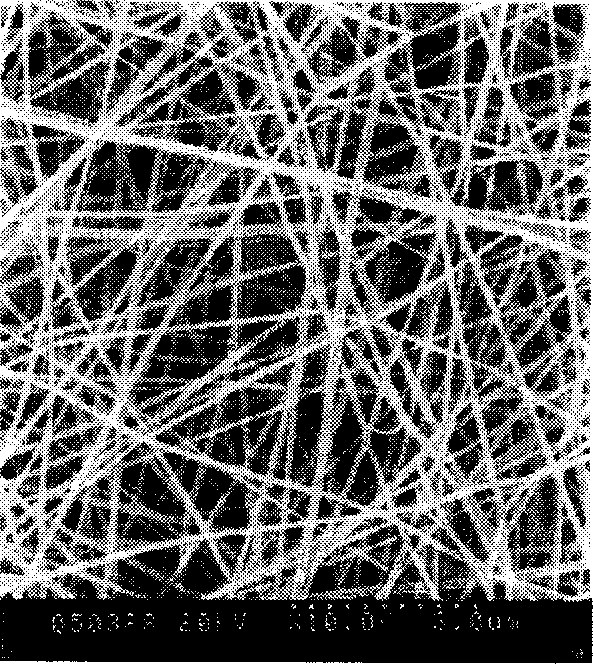Cell culturing rack material and its prepn
A scaffold material and cell culture technology, applied in the direction of coating, etc., can solve the problems of unfavorable cell growth and culture, low porosity, poor penetration of the upper and lower pores, etc., to achieve the best tissue compatibility, overcome poor strength, and good growth environment Effect
- Summary
- Abstract
- Description
- Claims
- Application Information
AI Technical Summary
Problems solved by technology
Method used
Image
Examples
Embodiment 1
[0026] 1. Put 0.2kg of waste mulberry silk into 6L of 0.05% sodium carbonate aqueous solution, boil for 0.5h, repeat the treatment three times, remove all the sericin around the silk, obtain silk fibroin, and dry at room temperature;
[0027] 2. Dissolve the dried silk fibroin with 1.2L of calcium chloride, water and ethanol solution with a molar ratio of 1:8:2 at 78±2°C to form a silk fibroin solution;
[0028] 3. Pour the silk fibroin solution prepared in step 2 into a cellulose dialysis bag, first dialyze with tap water, then dialyze with deionized water to remove ethanol and calcium chloride small molecules in the solution, and then use multi-layer degreasing Filter through gauze to obtain pure silk fibroin solution;
[0029] 4. Take 100ml of pure silk fibroin solution and pour it into an area of 20×20cm 2 In a polystyrene plastic tray, dry and form a film at constant temperature and humidity (25°C, RH65%), take off the regenerated silk fibroin film and pack it into a b...
Embodiment 2
[0036] 1. Put 0.1kg of waste silk into 3L of 0.05% sodium carbonate aqueous solution, boil for 0.5h, repeat the treatment three times, remove all the sericin around the silk, and obtain silk fibroin;
[0037] 2. Dissolve the dried silk fibroin obtained in step 1 with 0.6 L of calcium chloride, water, and ethanol solution with a molar ratio of 1:8:2 at 78±2° C. to form a silk fibroin solution;
[0038] 3. Pour the above-mentioned silk fibroin solution into a cellulose dialysis bag, dialyze with tap water first, and then dialyze with deionized water to remove ethanol and small calcium chloride molecules in the solution, and then filter with multi-layer degreasing gauze to prepare Obtain pure silk fibroin solution;
[0039] 4. Take 100ml of pure silk fibroin solution and pour it into an area of 20×20cm 2 In a stainless steel plate, freeze at -20°C for 8 hours, and then vacuum-dry in a freeze dryer for 20 hours to obtain a spongy regenerated silk fibroin film.
[0040] 5. Weig...
Embodiment 3
[0046] 1. Put 0.2kg of waste mulberry silk into 6L of 0.05% sodium carbonate aqueous solution, boil for 0.5h, repeat the treatment three times, remove all the sericin around the silk, obtain silk fibroin, and dry at room temperature;
[0047] 2. Dissolve the dried silk fibroin with 1.2L of calcium chloride, water and ethanol solution with a molar ratio of 1:8:2 at 78±2°C to form a silk fibroin solution;
[0048] 3. Pour the silk fibroin solution prepared in step 2 into a cellulose dialysis bag, first dialyze with tap water, then dialyze with deionized water to remove ethanol and calcium chloride small molecules in the solution, and then use multi-layer degreasing Filter through gauze to obtain pure silk fibroin solution;
[0049] 4. Take 100ml of pure silk fibroin solution and pour it into an area of 10×20cm 2 In a polystyrene plastic tray, dry and form a film at constant temperature and humidity (25°C, RH65%), take off the regenerated silk fibroin film and pack it into a b...
PUM
| Property | Measurement | Unit |
|---|---|---|
| diameter | aaaaa | aaaaa |
| pore size | aaaaa | aaaaa |
| diameter | aaaaa | aaaaa |
Abstract
Description
Claims
Application Information
 Login to View More
Login to View More - R&D
- Intellectual Property
- Life Sciences
- Materials
- Tech Scout
- Unparalleled Data Quality
- Higher Quality Content
- 60% Fewer Hallucinations
Browse by: Latest US Patents, China's latest patents, Technical Efficacy Thesaurus, Application Domain, Technology Topic, Popular Technical Reports.
© 2025 PatSnap. All rights reserved.Legal|Privacy policy|Modern Slavery Act Transparency Statement|Sitemap|About US| Contact US: help@patsnap.com


